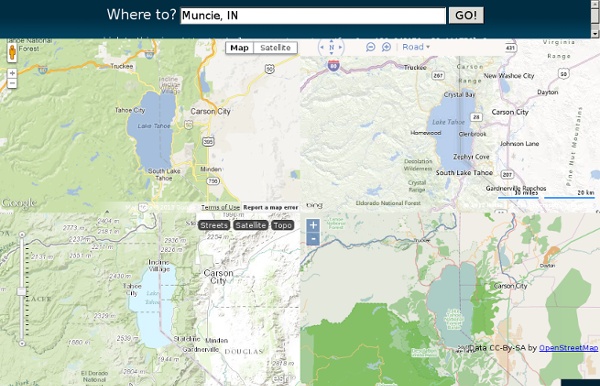



TOPOMAPPER Compare Maps Nutzungsbedingungen Scale = 1 : 111m z:3 2000 km 1000 mi Base Layer Topographic Maps (Zoom In) Google Street Map Google Hybrid Map Google Terrain Map Bing Street Map Bing Hybrid Map Yahoo Street Map Yahoo Hybrid Map OpenStreetMap (Mapnik) OpenStreetMap (Tiles@Home) Map data hosted by Atlogis Topographic Maps (Zoom In) Google Street Map Google Hybrid Map Google Terrain Map Yahoo Street Map Yahoo Hybrid Map OpenStreetMap (Mapnik) OpenStreetMap (Tiles@Home) Click here for URL-Link of this View | Topographic Maps Coverage | Soviet Military Maps Documentation Flood Map Water Level Elevation Map transparent map comparison openstreetmap google bing yahoo Données cartographiques ©2013 - Conditions d'utilisation Base Layer Google Streets Google MapMaker Google Aerial Google Physical Overlays OpenStreetMap Mapnik OSM Mapnik german style OSM Cycle Map ÖPNV Karte Mapquest OSM Hillshading Hiking Map ADFC Bicyclenetwork Map data © OpenStreetMap and contributors CC-BY-SA , NASA SRTM Permalink
Global Population Density at a Glance (Infographic) Fathom Information Design/Promo image This population density map is making the rounds on the blogs today, to near-universal acclaim. And for good reason; it might be the most intuitive look at global pop. density ever cobbled together. The brainchild of Fathom Information Design, 'Dencity' uses small pixels to connote density, big ones to convey wide-open, unpopulated spaces. Fast Company explains why the design works: In the visual syntax of infographics and maps, bigger equals... well, bigger. Fathom Information Design/Promo image I don't really get what's so unorthodox about this; to me, it seems downright intuitive. China. Counterintuitive or not, it is indeed a brilliantly effective way to convey where population centers are grouped, and where there's still free range. Click here to view a larger image.
Global 500 2010: Maps - Top 500 Companies are ranked by total revenues for their respective fiscal years ended on or before March 31, 2015. All companies on the list must publish financial data and report part or all of their figures to a government agency. Figures are as reported, and comparisons are with the prior year’s figures as originally reported for that year. Revenues Revenue figures include consolidated subsidiaries and reported revenues from discontinued operations, but exclude excise taxes. Profits Profits are shown after taxes, extraordinary credits or charges, cumulative effects of accounting changes, and noncontrolling (minority) interests, but before preferred dividends. Balance Sheet Assets shown are those at the company’s fiscal year-end. Employees The figure shown is either a fiscal year-end or yearly average number, as published by the company. Medians Credits This year’s Fortune Global 500 was prepared under the direction of list editor Scott DeCarlo.
ceriscope Atlas of Urban Expansion Massive urbanization, accompanied by the rapid expansion of cities and metropolitan regions and the sprawling growth of megacities the world over, is one of the most important transformations of our planet. Much of this explosive growth has been unplanned. Cities in developing countries have been unprepared for absorbing the many millions of the rural poor that are still crowding into informal settlements. These cities are now scheduled to double their urban population in the next thirty years, and possibly triple the land area. The Atlas of Urban Expansion provides the geographic and quantitative dimensions of urban expansion and its key attributes in cities the world over. The Atlas of Urban Expansion is also available as a printed book. Use of data should include the following citation: Angel, S., J.
La population urbaine mondiale de 1950 à 2050 - carte statistique interactive de l'UNICEF | Enseigner l'Histoire-Géographie Les blonds en Europe Détails Création : 21 juillet 2010 Parce que cette information est sans importance, elle devient donc fondamentale ! Pour toutes les personnes qui cherchent à savoir où se trouvent les blonds et blondes en Europe, voici une réponse sous forme de mosaïque isometrique ou isoCarte.Cette carte a été réalisée par votre serviteur via les données du site www.eupedia.com. Carte : Pourcentage des cheveux blonds en Europe Une conclusion s'impose : il faut aller dans le nord de l'Europe, dans les pays scandinaves, pour trouver de fortes populations aux cheveux clairs. www.le-cartographe.net
EuroMéditerranée <object id="UnityObject" classid="clsid:444785F1-DE89-4295-863A-D46C3A781394" width="1000" height="650" codebase=" name="src" value="uploads/tx_t3unity3d/WebPlayer.unity3d" /><embed id="UnityEmbed" src="uploads/tx_t3unity3d/WebPlayer.unity3d" width="1000" height="650" type="application/vnd.unity" pluginspage=" /><noembed><div align="center"> This content requires the Unity Web Player, please click the button below to visit the Unity Web Player download page.</p><p><a href=' src=' border='0'/></a></div></noembed></object>